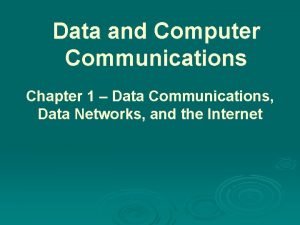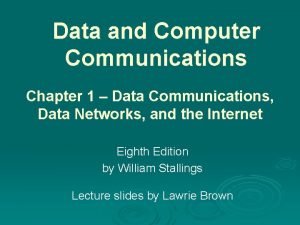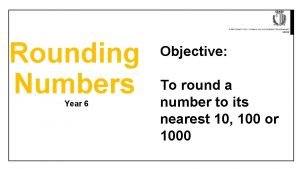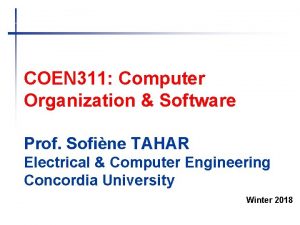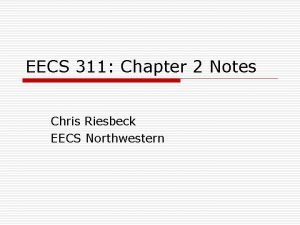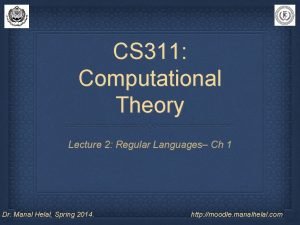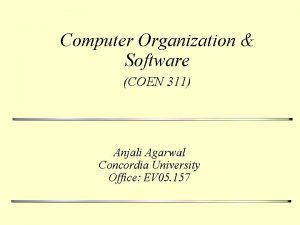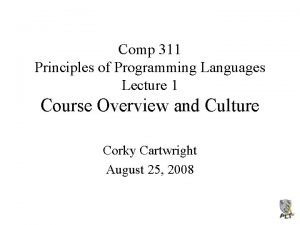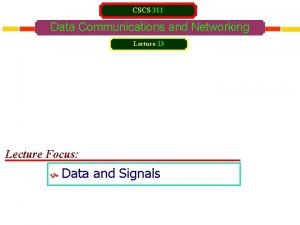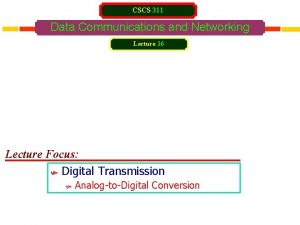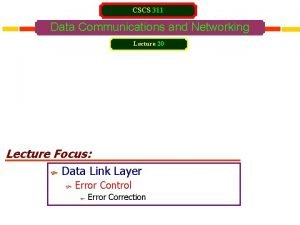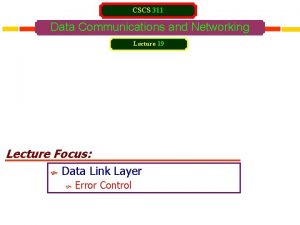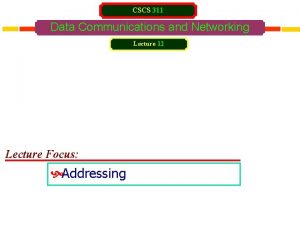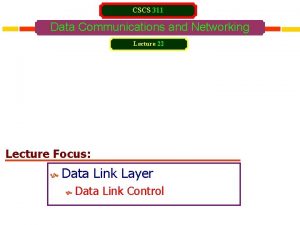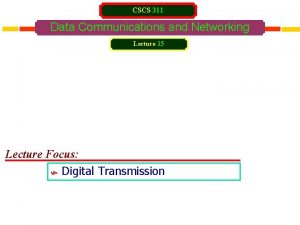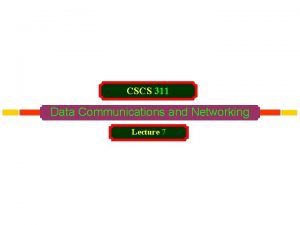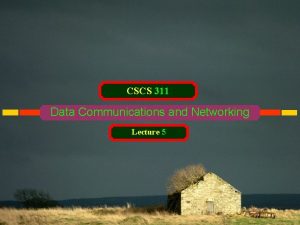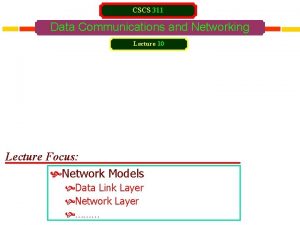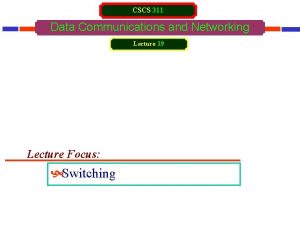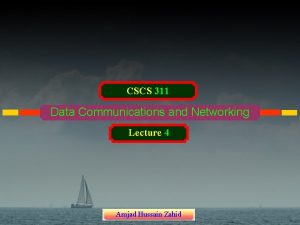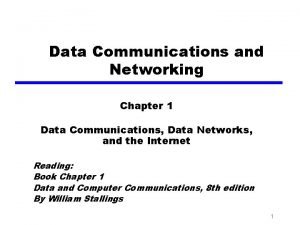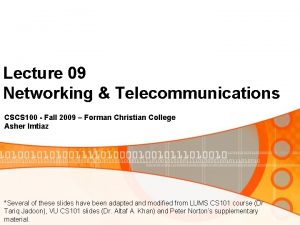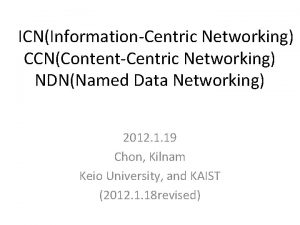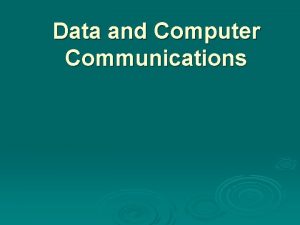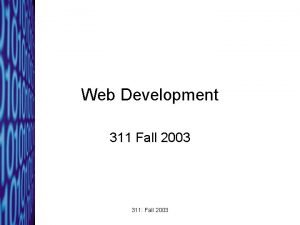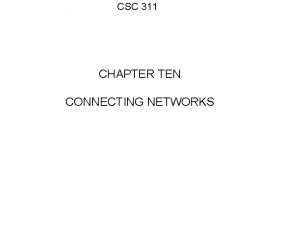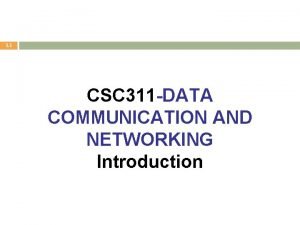CSCS 311 Data Communications and Networking Lecture 14



































- Slides: 35

CSCS 311 Data Communications and Networking Lecture 14 Lecture Focus: Transmission Impairment

Transmission Impairment Signals travel through transmission media, which are not perfect. The imperfection causes signal impairment. This means that the signal at the beginning of the medium is not the same as the signal at the end of the medium. What is sent is not what is received. Three causes of impairment are: Attenuation Distortion Noise

Transmission Impairment types

Transmission Impairment types Attenuation means a loss of energy. When a signal travels through a medium, it loses some of its energy in overcoming the resistance of the medium. That is why a wire carrying electric signals gets warm, if not hot, after a while. Some of the electrical energy in the signal is converted to heat. To compensate for this loss, amplifiers are used to amplify the signal. Due to resistance

Transmission Impairment types Attenuation Figure below shows the effect of attenuation and amplification.

Transmission Impairment Attenuation Decibel To show that a signal has lost or gained strength, we use the unit of the decibel. The decibel (d. B) measures the relative strengths of two signals or one signal at two different points. Note that the decibel is: Negative if a signal is attenuated and Positive if a signal is amplified. PI and P 2 are the powers of a signal at points 1 and 2, respectively.

Transmission Impairment Attenuation Decibel Note that some books define the decibel in terms of voltage instead of power. In this case, because power is proportional to the square of the voltage, the formula is: d. B = 20 log 10 (V 2 / V 1)

Transmission Impairment Attenuation Decibel Note that some books define the decibel in terms of voltage instead of power. In this case, because power is proportional to the square of the voltage, the formula is: d. B = 20 log 10 (V 2 / V 1)

Transmission Impairment Attenuation Example Suppose a signal travels through a transmission medium and its power is reduced to one-half. This means that P 2 = ½ P 1. In this case, the attenuation (loss of power) can be calculated as: d. B = 10 log 10 (P 2 / P 1) = 10 log 10 (1/2 P 1 / P 1) = 10 log 10 (0. 5)) = 10 (-0. 3) d. B = -3 Other Numerical Examples from book

Transmission Impairment Distortion means that the signal changes its form or shape. Distortion can occur in a composite signal made of different frequencies. Each signal component has its own propagation speed through a medium and, therefore, its own delay in arriving at the final destination. Differences in delay may create a difference in phase if the delay is not exactly the same as the period duration. In other words, signal components at the receiver have phases different from what they had at the sender. The shape of the composite signal is therefore not the same. Due to propagation speeds

Transmission Impairment Distortion Figure below shows the effect of distortion on a composite signal.

Transmission Impairment Noise is another cause of impairment. Several types of noise, such as thermal noise, induced noise, cross-talk, and impulse noise, may corrupt the signal. Thermal noise is the random motion of electrons in a wire which creates an extra signal not originally sent by the transmitter. Induced noise comes from sources such as motors and appliances. These devices act as a sending antenna, and the transmission medium acts as the receiving antenna. Cross-talk is the effect of one wire on the other. One wire acts as a sending antenna and the other as the receiving antenna. Impulse noise is a spike (a signal with high energy in a very short time) that comes from power lines, lightning, and so on.

Transmission Impairment Noise Figure shows the effect of noise on a signal.

Transmission Impairment Noise Signal-to-Noise Ratio (SNR) To find theoretical bit rate limit, we need to know the ratio of the signal power to the noise power. The signal-to-noise ratio is defined as: SNR = average signal power / average noise power We need to consider the average signal power and the average noise power because these may change with time.

Transmission Impairment Noise Figure shows the idea of SNR

Transmission Impairment Noise Signal-to-Noise Ratio (SNR) SNR is actually the ratio of what is wanted (signal) to what is not wanted (noise). A high SNR means the signal is less corrupted by noise; A low SNR means the signal is more corrupted by noise. Because SNR is the ratio of two powers, it is often described in decibel units, SNRd. B, defined as: SNRd. B = 10 log 10 SNR

Transmission Impairment Noise Signal-to-Noise Ratio (SNR) Example

Data Rate Limits A very important consideration in data communications is how fast we can send data, in bits per second. over a channel. Data rate depends on three factors: 1. The bandwidth available 2. The level of the signals we use 3. The quality of the channel (the level of noise) Two theoretical formulas were developed to calculate the data rate: By Nyquist: For a noiseless channel By Shannon: For a noisy channel.

Data Rate Limits Noiseless Channel: Nyquist Bit Rate For a noiseless channel, the Nyquist bit rate formula defines theoretical maximum bit rate Bit Rate = 2 x bandwidth x 10 g 2 L In this formula, bandwidth is the bandwidth of the channel, L is the number of signal levels used to represent data, and Bit Rate is the bit rate in bits per second.

Data Rate Limits Noiseless Channel: Nyquist Bit Rate = 2 x bandwidth x 10 g 2 L According to the formula, we might think that, given a specific bandwidth, we can have any bit rate we want by increasing the number of signa 1 leve 1 s. Although the idea is theoretically correct, practically there is a limit. When we increase the number of signal 1 eve 1 s, we impose a burden on the receiver. If the number of levels in a signal is just 2, the receiver can easily distinguish between a 0 and a 1. If the level of a signal is 64, the receiver must be very sophisticated to distinguish between 64 different levels. In other words, increasing the levels of a signal reduces the reliability of the system.

Data Rate Limits Noiseless Channel: Nyquist Bit Rate Example Consider a noiseless channel with a bandwidth of 3000 Hz transmitting a signal with two signal levels. What is the maximum bit rate? Bit Rate = 2 x bandwidth x 10 g 2 L Bit Rate =2 x 3000 x log 2 2 =6000 bps

Data Rate Limits Noiseless Channel: Nyquist Bit Rate Example Consider the same noiseless channel transmitting a signal with four signal levels (for each level, we send 2 bits). What is the maximum bit rate? Bit Rate = 2 x bandwidth x 10 g 2 L Bit Rate =2 x 3000 x log 2 4 =12, 000 bps

Data Rate Limits Noisy Channel: Shannon Capacity In reality, we cannot have a noiseless channel; the channel is always noisy. In 1944, Claude Shannon introduced a formula, called the Shannon capacity, to determine theoretical highest data rate for a noisy channel: Capacity =bandwidth X log 2 (1 +SNR) In this formula, bandwidth is the bandwidth of the channel, SNR is the signal-to-noise ratio, and capacity is the capacity of the channel in bits per second.

Data Rate Limits Noisy Channel: Shannon Capacity =bandwidth X log 2 (1 +SNR) Note that in the Shannon formula there is no indication of the signal level, which means that no matter how many levels we have, we cannot achieve a data rate higher than the capacity of the channel. In other words, the formula defines a characteristic of the channel, not the method of transmission.

Data Rate Limits Noisy Channel: Shannon Capacity Example Consider an extremely noisy channel in which the value of the signal-to-noise ratio is almost zero. In other words, the noise is so strong that the signal is faint. For this channel the capacity C is calculated as: Capacity = bandwidth X log 2 (1 +SNR) = bandwidth X log 2 (1 +0) = bandwidth X log 2 (1) = bandwidth X 0 =0 This means that the capacity of this channel is zero regardless of the bandwidth. In other words, we cannot receive any data through this channel.

Bandwidth One characteristic that measures network performance is bandwidth. However, the term can be used in two different contexts with two different measuring values: bandwidth in hertz and bandwidth in bits per second Bandwidth in Hertz Bandwidth in hertz is the range of frequencies contained in a composite signal or the range of frequencies a channel can pass. For example, we can say the bandwidth of a subscriber telephone line is 4 k. Hz.

Bandwidth in Bits per Seconds The term bandwidth can also refer to the number of bits per second that a channel, a link, or even a network can transmit. For example, one can say the bandwidth of a Fast Ethernet network (or the links in this network) is a maximum of 100 Mbps. This means that this network can send 100 Mbps.

Throughput The throughput is a measure of how fast we can actually send data through a network. Although, bandwidth in bits per second and throughput seem the same, they are different. A link may have a bandwidth of B bps, but we can only send T bps through this link with T always less than B. In other words, the bandwidth is a potential measurement of a link; the throughput is an actual measurement of how fast we can send data. For example, we may have a link with a bandwidth of 1 Mbps, but the devices connected to the end of the link may handle only 200 kbps. This means that we cannot send more than 200 kbps through this link. Imagine a highway designed to transmit 1000 cars per minute from one point to another. However, if there is congestion on the road, this figure may be reduced to 100 cars per minute. The bandwidth is 1000 cars per minute; the throughput is 100 cars per minute.

Throughput Example A network with bandwidth of 10 Mbps can pass only an average of 12, 000 frames per minute with each frame carrying an average of 10, 000 bits. What is the throughput of this network? Solution We can calculate throughput as: Throughput= 12, 000 x 10, 000 / 60 = 2 Mbps The throughput is almost one-fifth of the bandwidth in this case.

Latency (Delay) The latency or delay defines how long it takes for an entire message to completely arrive at the destination from the time the first bit is sent out from the source. Latency is made of four components: Propagation time Transmission time Queuing time and Processing delay Latency = propagation time + transmission time + queuing time + processing delay

Latency (Delay) Propagation Time The time required for a bit to travel from the source to the destination. The propagation time is calculated by dividing the distance by the propagation speed. Propagation time = Distance / Propagation speed

Latency (Delay) Propagation Time The propagation speed of electromagnetic signals depends on the medium and on the frequency of the signal. For example, in a vacuum, light is propagated with a speed of 3 x 108 m/s. It is lower in air; it is much lower in cable. Example What is the propagation time if the distance between the two points is 12, 000 km? Assume the propagation speed to be 2. 4 x 108 m/s in cable. Solution Propagation time = Distance / Propagation speed Propagation time = 12000 x 1000 / 2. 4 x 108 = 50 ms

Latency (Delay) Transmission Time We don't send just 1 bit, we send a message. The first bit may take a time equal to the propagation time to reach its destination; the last bit also may take the same amount of time. However, there is a time between the first bit leaving the sender and the last bit arriving at the receiver. The first bit leaves earlier and arrives earlier; the last bit leaves later and arrives later. The time required for transmission of a message depends on the size of the message and the bandwidth of the channel. Transmission time = Message Size / Bandwidth

Latency (Delay) Example What are the propagation time and the transmission time for a 2. 5 KB message (an e-mail) if the bandwidth of the network is 1 Gbps? Assume that the distance between the sender and the receiver is 12, 000 km and that light travels at 2. 4 x 108 m/s. Solution Propagation time = Distance / Propagation speed Propagation time = 12000 x 1000 / 2. 4 x 108 = 50 ms Transmission time = Message Size / Bandwidth Transmission time = 2500 x 8/109 = 0. 020 ms

Latency (Delay) Queuing Time The third component in latency is the queuing time, the time needed for each intermediate or end device to hold the message before it can be processed. The queuing time is not a fixed factor; it changes with the load imposed on the network. When there is heavy traffic on the network, the queuing time increases. An intermediate device, such as a router, queues the arrived messages and processes them one by one. If there are many messages, each message will have to wait.
 Cscs
Cscs Business data communications and networking
Business data communications and networking Business data communication and networking
Business data communication and networking Introduction to data communications and networking
Introduction to data communications and networking Business data communications and networking
Business data communications and networking Traditional network vs sdn
Traditional network vs sdn Crisis communication lecture
Crisis communication lecture 01:640:244 lecture notes - lecture 15: plat, idah, farad
01:640:244 lecture notes - lecture 15: plat, idah, farad Computer networks assignment 1
Computer networks assignment 1 Telecommunication meaning
Telecommunication meaning Data and computer communications 10th edition
Data and computer communications 10th edition Data and computer communication
Data and computer communication Data and computer communications
Data and computer communications William stallings data and computer communications
William stallings data and computer communications Jellyfish networking data centers randomly
Jellyfish networking data centers randomly Hpe data center networking
Hpe data center networking Data center switching gartner
Data center switching gartner Uw cse 312
Uw cse 312 Art 294 a 311 novo cpc
Art 294 a 311 novo cpc Csci 311
Csci 311 Ist 311
Ist 311 Round 372 to the nearest 10
Round 372 to the nearest 10 Psyc 311
Psyc 311 Rtca do-227
Rtca do-227 Rpv311
Rpv311 Coen311
Coen311 Find an inverse of 101 modulo 4620
Find an inverse of 101 modulo 4620 What is number theory
What is number theory Ssis 311
Ssis 311 Eecs 311
Eecs 311 Cs 311
Cs 311 A2yes
A2yes 311 k
311 k Anjali agarwal concordia
Anjali agarwal concordia Comp 311 study guide
Comp 311 study guide Gc 311
Gc 311











